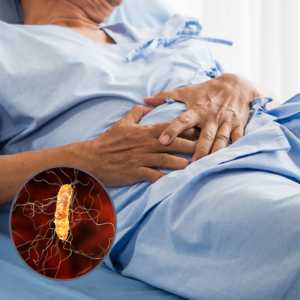Interventional Care


We notice that you are visiting us from . This site only services US-based visitors. Would you like to visit the site that is appropriate for your location?

While employed at a community hospital, caring for patients post operatively, I observed that within a short period of time many of the patients had developed symptoms of a C. diff. infection (CDI). After obtaining a doctor’s order for a C. diff. laboratory test, one of the patients tested had a new diagnosis added to their chart; Clostridioides difficile (formally known as Clostridium difficile).
What is C. diff.?
According to the US Centers for Disease Control and Prevention (CDC), C. diff. is the most common healthcare-associated infection (HAI)[1]. It is one of the many types of bacteria found in the environment and human gastrointestinal (GI) tract, and approximately one out of twenty healthy individuals may carry this organism in their gastrointestinal system2. When individuals are prescribed antibiotics to treat bacterial infections, some of the normal bacteria in the intestine dies, and C. diff. bacteria can move down to the large intestine (colon) multiply and create toxins which cause the C. diff. infection symptoms2.
Who is at risk?
Those who have a high risk of acquiring a CDI are our senior population, those who remain in the hospital for any prolonged period of time, individuals residing in long-term care facilities, individuals diagnosed with serious illnesses, individuals with weakened immune systems, and those who have gastrointestinal diagnosis2.
Symptoms of a C. diff. Infection (CDI):
Diarrhea is the leading and most common symptom of a C. diff. infection with three or more watery stools within twenty-four hours3. C. diff infection may include symptoms of diarrhea, abdominal pain, fever, fatigue, and can advance to a complication of a severe inflammation of the colon called pseudomembranous colitis, which can also lead to further complications of disease called toxic megacolon4.
For more than four months, I was experiencing painful abdominal cramping after eating any food, which lead to frequent bouts of diarrhea within an hour of eating. While at work I refrained from eating or drinking not to experience these horrible symptoms and later learned that three of my coworkers were living with the same symptoms. Visits to the family practitioner began four months prior to being diagnosed with a C. diff. infection. Visits to the physician’s office went from once a week to twice a week to three times a week. Finally, one of my coworkers’ physician ordered a stool test for C. diff. and confirmed the diagnosis. After learning that news, the coworkers, and I shared the information with our family practitioners who ordered CDI stool tests and confirmed that the symptoms we were suffering were caused by a C. diff. infection.
A Foundation is formed:
In 2004, my father died from sepsis and a C. diff. infection, and through my own personal survival of two separate C. diff. infections, each with over eight recurrences, the C Diff Foundation came to fruition on November 1st, 2012. The Foundation’s mission is to educate and advocate for C. diff. infection prevention, treatments, clinical trials, and environmental safety worldwide.
The C Diff Foundation members and volunteer health advocates run double-time especially during the month of November to share the important information with healthcare professionals, patients, families, seniors, and the general public following our mission.
This life-saving information, raising C. diff. awareness, is complicated this year due to the COVID-19 global pandemic. However, we have overcome the restrictions by creating new and accessible ways to meet the goals and reach the public.
The Birth of C. diff. Awareness Month:
Since 2017, the C Diff Foundation, and partners of the Foundation, have been communicating with Governors across the U.S., requesting that November be proclaimed “November is Clostridioides difficile (C. diff., C. difficile) Infection Awareness” month. We are profoundly grateful for the Governors’ continued support granting the annual state proclamations to raise C. diff. awareness with dedicated organizations, and individuals across the nation.
Awareness and Education:
November 14th marks the 8th Annual International C. diff. Conference and Health EXPO which will provide objectives that are beneficial to healthcare professionals in all specialties, researchers, and pharmaceutical professionals. The C Diff Foundation’s Junior Infection Fighters program will also be introduced. This program was created for children ages seven to fourteen who are interested in learning about infection prevention and hand-hygiene, CDI education, as well as an introduction to the human gut microbiome, bacteria, and viruses.
November 23rd is the Inaugural Patient and Family Symposium, an online ZOOM meeting created with patients, families, and caregivers in mind. Presentations will be delivered by healthcare professionals, C. diff. survivors, and researchers sharing practical information to benefit this special audience.
One Infection is One Too Many:
No one should ever experience the pain and suffering the body endures from even one C. diff. infection. The losses caused by this life-threatening infection, expands past the mind and body. As with any catastrophic illness, the patient and families are not prepared for the extended losses – loss of wages, loss of insurance, loss of attending social events, loss of income resulting in difficulties obtaining medical care and medications, as well as supporting household expenses.
Through unwavering efforts and determination, the C Diff Foundation focuses on the means to prevent the pain and loss caused by this infection. Everyone can help by providing individuals with the knowledge to develop stronger advocacy skills that will benefit their healthcare and create continued healing.
Learn more about the C Diff Foundation
1 https://www.cdc.gov/hai/dpks/deadly-diarrhea/dpk-deadly-diarrhea.html
2 https://www.cdc.gov/cdiff/risk.html
3 https://www.cdc.gov/cdiff/what-is.html
4 Clostridium difficile (C. difficile, C.diff.) Guidelines for Adults and Children 2017 Update by Infectious Diseases Society of America (IDSA) and Society for Healthcare Epidemiology of America (SHEA) February 2017